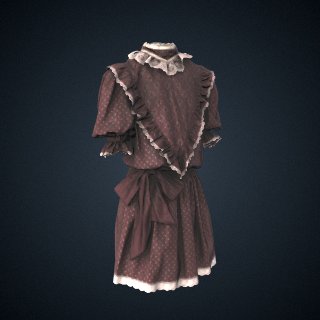Object Details
- Description
- Sarah Leavitt’s Bat Mitzvah, Madison, Wisconsin, 1983
- Religious communities have long played a role in defining the transition from girlhood to womanhood with rites of passage. Yet, girls take on these traditions and remake them in different ways.
- In the synagogue, a thirteen-year-old boy becomes a man at his Bar Mitzvah. But no comparable ceremony sanctified girls’ coming of age until 1922, when a New York rabbi invented Bat Mitzvah for his daughter. By the late 1900s, Jewish girls had claimed the millennia-old ritual known as the Bar Mitzvah for themselves.
- Sarah Leavitt grew up in Madison, where she celebrated her Bat Mitzvah at Temple Beth El. Both the boys and girls in her class took on the responsibilities of being a Jewish adult at age 13. However, the girls did not wear the traditional prayer shawl (tallit) or head covering, (yarmulke) that were still, then, only worn by the boys.
- Bat Mitzvah’s often meant a new dress and a party. Reminiscent of Victorian romance, this Gunne Sax dress was all the rage in the early 1980s.
- Location
- Currently not on view
- See more items in
- Work and Industry: Work
- Data Source
- National Museum of American History
- ID Number
- 2018.0254.1
- accession number
- 2018.0254
- catalog number
- 2018.0254.1
- Object Name
- dress
- Physical Description
- textile (overall material)
- Measurements
- overall, flat: 88 cm x 65 cm x 1 cm; 34 21/32 in x 25 19/32 in x 13/32 in
- overall, mounted: 32 in x 20 in x 14 in; 81.28 cm x 50.8 cm x 35.56 cm
- Record ID
- nmah_1900832
- Metadata Usage
- CC0
Related Object Groups
There are restrictions for re-using this image. For more information, visit the Smithsonian's Terms of Use page .
These files consist of 3D scans of historical objects in the collections of the Smithsonian and may be downloaded by you only for non-commercial, educational, and personal uses subject to this disclaimer (https://3d.si.edu/disclaimer) and in accordance with the Terms of Use (https://3d.si.edu/termsofuse).
International media Interoperability Framework
IIIF provides researchers rich metadata and media viewing options for comparison of works across cultural heritage collections. Visit the IIIF page to learn more.

3D Model

